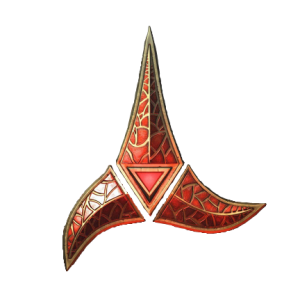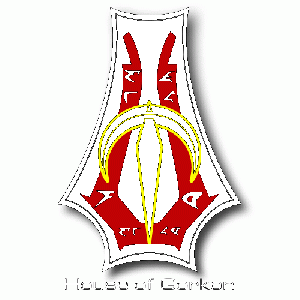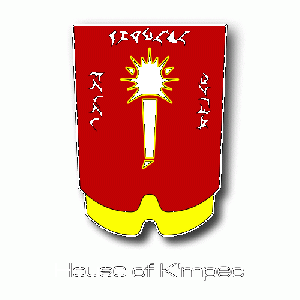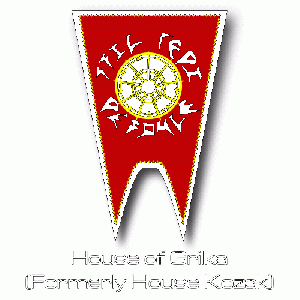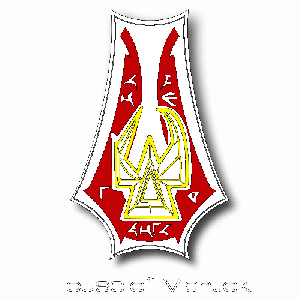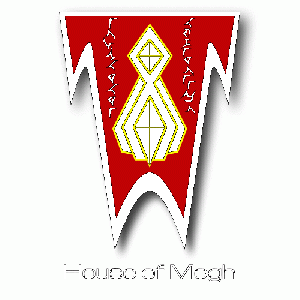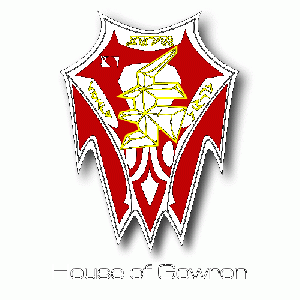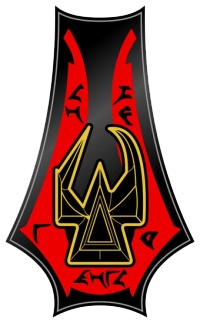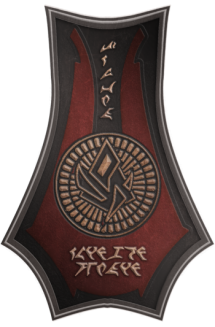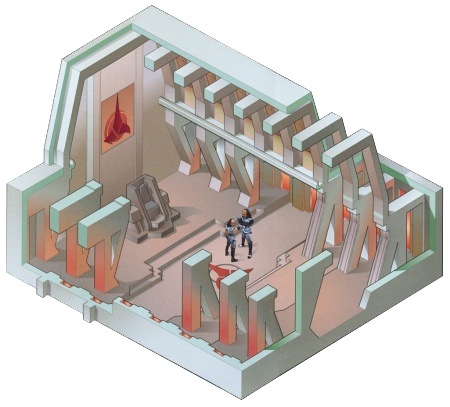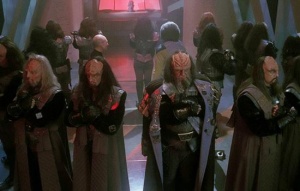Klingon Great Houses
From Star Trek: Theurgy Wiki
"The Great Houses and their games dominate our Empire... Alliances of blood and blades, these organizations define the political state of Qo'noS."
- -- Loresinger B'Alea.
The Great Houses are major political institutions in the Klingon Empire and consist of influential families, most of them of noble descent. Some of the Houses are descendants of Kahless.
When Kahless united the Klingon people, he did so under the banner of Klingons being warriors who would lead the charge into the glory of battle and combat. But in his wisdom, Kahless also recognized two important truths: that not every Klingon is suited to be a warrior, and that no society can survive long if everyone is a warrior.
To that end, he and his mate, the Lady Lukara, codified the Klingon caste system that still provides the structure of the Empire in the 24th century.
Organization
At the top of the Klingon caste system are the warriors of the Empire. All members of the warrior caste are part of a House, which includes their entire family. The House is generally named after the current House head or epetai, though some are named after historical figures who have been part of the House in the past. (As an example, the House of Kor was, for a time, named the House of Mur'Eq, as he was a great and noble emperor.)
Great Houses are united by bloodline and led by a male Klingon. Upon the death of the head of the House and his heir, the Mistress will take over control until a new male is found to take this position. The Mistress, usually titled Lady, is the highest-ranking woman in the House, either the mother or wife of the House leader. A House is named for its current leader but he also has the option of continuing the use of his father's name.
A House's status and holdings shift and change regularly. If a House has many warriors who succeed in battle, their status can increase. Altercations between Houses are very common and can last for centuries. Often battles between Houses can result in one House taking over another. And if a House falls, due to too many losses in battle, or dishonorable behavior, or simply dying out naturally, then its holdings will be granted by the High Council to another House that is worthy of them. There has rarely been a time when there were a set number of major Houses, and those times have been fleeting.
House Emblems
Each Great House possesed a unique house emblem. These emblems could be found adorning the baldrics of the house's epetai, branded upon house assets, or displayed upon house banners.
Examples of Famous House Banners
Political Influence
On Qo'noS the political life is defined by the alliance of Great Houses. The most powerful Houses even possess their own fleets. Thus, to govern the Empire the Klingon High Council relies on the support of the families.
Once, all the major Houses were represented on the High Council, but there are far more major Houses than there are Council seats - and, in truth, not every major House wishes to involve themselves in politics. The Council consists of members representing the twenty-four most influential Houses and is headed by a single Chancellor. The Chancellor doesn't have to be of noble descent or a member of a Great House however he needs to be backed by at least one influential House. The Chancellor is understood to b the face of the Empire, not only to the Klingon people but to other interstellar powers.
A leader is judged not by the length of his reign but by the decisions he makes.
- --Kahless The Unforgettable
| Known Chancellors of the Klingon Empire | |||
|---|---|---|---|
| 2069-???? | Mow'ga | House of Mow'ga |  IMAGE UNAVAILABLE |
| ????-2073 | Karvan | House of Karvan |  IMAGE UNAVAILABLE |
| 2073-2073 | Kagga | House of Havrk |  IMAGE UNAVAILABLE |
| ????-2098 | 25 Years of Weak Chancellors |  IMAGE UNAVAILABLE | |
| 2098-2109 | Kapok |  IMAGE UNAVAILABLE | |
| 2109-2152 | Keth | House of Rivaki |  Chancellor Keth in 2151 |
| 2152-2165 | M'Rek | House of M'Rek | 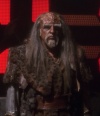 Chancellor M'Rek in 2153 |
| 2165-???? | Khorkal |  IMAGE UNAVAILABLE | |
| ????-???? | Kadyra |  IMAGE UNAVAILABLE | |
| 2247-2256 | Karhammur |  IMAGE UNAVAILABLE | |
| 2256-2256 | Kassa, son of Karhammur |  IMAGE UNAVAILABLE | |
| 2256-2256 | Kol, son of Kol-Sha | House of Kor | 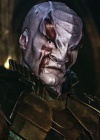 Chancellor Kol in 2256 |
| 2257-???? | L'Rell | House of T'Kuvma House of Mo'Kai |
 Chancellor L'Rell in 2257 |
| ????-2270 | Sturka | House of | 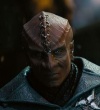 Chancellor Sturka in 2259 |
| 2270-2287 | Kesh | House of |  IMAGE UNAVAILABLE |
| 2287-2292 | Lorak | House of |  IMAGE UNAVAILABLE |
| 2292-2293 | Gorkon, son of Toq | House of Mokok |  Chancellor Gorkon in 2293 |
| 2293-2311 | Azetbur, daughter of Gorkon | House of Gorkon |  Chancellor Azetbur in 2293 |
| 2311-2323 | Kaarg | House of |  IMAGE UNAVAILABLE |
| 2323-2334 | Ditagh | House of |  IMAGE UNAVAILABLE |
| 2334-2346 | Kravokh, son of J'Doq | House of |  IMAGE UNAVAILABLE |
| 2345-2367 | K'mpec | House of K'mpec |  Chancellor K'mpec in 2366 |
| 2367-2375 | Gowron, son of M'Rel | House of Gowron | 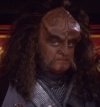 Chancellor Gowron in 2375 |
| 2375-2375 | Worf, son of Mogh | House of Martok | 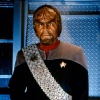 Chancellor Worf in 2375 |
| 2375-Present | Martok, son of Urthog | House of Martok |  Chancellor Martok in 2375 |
History of the Houses
"Klingons do not want to hear about the failures and wrongdoings of the past unless there is a hero
- to set them right."
- -- Chancellor Martok
- to set them right."
During the Time of Tyrants
Archeological evidence suggests that the earliest large-scale Klingon nations formed around 6,000 B.C.E. as a result of Klingon "houses" starting to form alliances. According to legend, a Klingon warlord named Kargas hit upon the idea of bringing different houses together without forcing them to become one house. Kargas and his allies are believed to have founded the Klingon city that still bears his name, the first true city-state on Qo'noS.
Although Klingon city-states were successful, they also grew too rapidly for the meager resources of their territory to sustain them. This led to the first large-scale wars in Klingon history, as city-states and alliances fought each other for control of valuable land and resources. Vast armies battled on the plains of Qo'noS, and city-states rose and fell based on the outcomes of those battles.
For many years, Qo'noS was a planet divided. Warlords and tyrants ruled their fiefdoms, warring with each other and holding onto their territories. The blood of many soldiers stained the ground of Qo'noS, as Klingon fought against Klingon for the pleasure of their rulers.
There was no honor in their conquest, there was only service to those who wielded power.
By the time of Kahless, dozens of tyrants ruled on Qo’noS: General Kizhar, warlord of the Kir Peninsula; Ralkror, who ruled from atop Goqlath Mountain; King Dezan of the island nation of Kall’ta; Chu’paq of the island of Kilgore; Queen B’Ela of the Skeera Peninsula; Gantin the Mighty; Kavru the Bold; Blaq the Indestructible; Maq of the eastern coast of Ham’ton; and so many more.
But the greatest tyrant of all, the greatest foe that Kahless had to face in his quest to unite the Klingon people, was Molor.
Kahless believed that honor should rule the day, that it was not enough simply to fight to please the whimsical needs of tyrants and warlords, but to enrich the spirit and bring greater glory to oneself. The Klingon people were either tyrants, slaves, or soldiers. Kahless believed that true greatness would be achieved if Klingons became warriors - and also if they fought for a common goal.
More than anything, Kahless believed that honor was the road which would lead all Klingons to glory, not just those few who ruled their tiny kingdoms. Kahless believed that they could be one people united on this world - and on all the others.
Not all Klingons believed in this philosophy - indeed, not all the Klingons in Kahless's own house, the House of Riskadh, believed it. Morath, Kahless's brother, lied and deceived others, including their own father, Kanjis. Kahless, revolted by that behavior, challenged Morath to combat, but Morath instead fled. Kahless pursued him all across the continent, through the valleys and mountains, until he caught up with him at the Bazho River. For twelve days and twelve nights, brother fought against brother until Kahless was triumphant.
As the victor, Kahless led his house and one by one, brought the wisdom of honor to the many warlords across Qo'noS. Some joined his cause by choice, convinced by Kahless's words; others by conquest, defeated by Kahless's might in combat, and by his ever-growing army. With each journey, with each victory, Kahless's forces grew larger, and the Klingons came closer and closer to being united under him.
At Qam-Chee, Kahless prepared to face Molor's forces. Two emissaries from other warlords had come to listen to Kahless's words and see if they should follow him. One was the Lady Lukara, sent by Blaq the Indestructable. While Blaq had no intention of joining Kahless's cause, Lukara found herself swayed by Kahless's words. When Molor's forces attacked the pass at Qam-Chee, Lukara stood by the Unforgettable One's side, and together they slew hundreds of Molor's troops in epic combat.
Even after the vicious defeat, Molor refused to bend his knee to Kahless. Kahless and Kukara took their forces to the fort at Qa'varin along the River Skral to confront Molor, where still Molor refused to surrender.
In the fires of the Kri'stak Volcano, using a hair from his head, Kahless forged the first bat'leth, the sword of honor used now by all true warriors. With the bat'leth, and after days and days of mighty battle, Kahless severed Molor's head from his body, at last uniting the various houses of the Klingon people on Qo'noS under one flag and forging the First Klingon Empire.
During the Age of Heroes
Today the Klingon Empire's territory is still divided into numerous fiefdoms dominated by Houses - both large and small. These families rule their lands directly with absolute authority and can consist of anything between small planetary regions to entire planets with the more powerful Houses controlling several planets. This shows itself as a petty group of Houses that are bound together for mutual benefit that resembles some ancient societies on Earth rather than an intergalactic power.
Within each House, there exists their own military force, training facilities, arsenals and even shipyards maintained by its occupants. A House that wins many battles and controls great swathes of land, the more successful it is which means even more warriors will join its ranks. As such, the House is the most important aspect in a Klingon warriors life and it defines their allegiance. This means that its often that a Klingons loyalty is stronger to his House than his dedication to the Empire itself. This means that every honorable warrior serves his House with undying devotion. (Decipher RPG module: Aliens)
- 820 - Kahless defeats Molor in an epic personal duel, uniting the Klingon people.
- In 2069, the Klingon High Council assumed control of the government after the death of Koth, the last Klingon emperor. Thus begins the Second Klingon Empire, led by the Chancellor of the Council, power was seized quickly, preventing a civil war.
- In 2362, The House of Chang was involved in a minor war with the House of Prel'Voq.
- Late in the 23th century, the Houses of B'vat and Mo'kai clashed, starting a century-long blood feud.
- Early in 2381 Gorka, son of Margon of House Mo'Kai makes a bid to challenge Chancellor Martok for control of the High Council resulting in the Battle of the Houses.
Battle of the Houses (2381)
Early in 2381 Gorka, son of Margon of House Mo'Kai made a bid to challenge Chancellor Martok for control of the High Council resulting in the Battle of the Houses. Assembling allied fleets from among houses opposed to Martok's leadership of the Empire, Gorka positioned himself to take the chancellorship by force. Martok, a veteran of the Dominion War, was no toothless targ and had an equal-sized armada of allied house fleets to defend his office.
| Houses Aligned with Martok | Houses Aligned with Gorka |
|---|---|
| House of Martok | House of Mo'Kai |
| House of B'Vat | House of Hurgas |
| House of Hurgoh | House of J'mpok |
| House of Kahnrah | House of Duras |
| House of Lorgh | House of Kular |
| House of Noggra | House of Napos |
| House of Targesh | House of Torg |
| House of Vrag | House of Varnak |
| House of Torlek | House of Sanar |
| House of DachoH | House of D'Ghor |
Great Houses
The greatest of the Houses are the ones with the noblest warriors, the greatest records of battle, the most foes defeated, and the most profound influence on the history of the Empire. These are the Houses whose scions crew the finest vessels in the Klingon Defense Force, and also serve on the High Council. They are the generals, the captains, the Dahar Masters, the chancellors. They are the force behind the Empire.
Great Houses in the High Council (2381)
- Providing the Chancellor: House of Martok: Martok, son of Urthog
- House of J'mpok: Councilor J'mpok, son of Q'thoq
- House of Kopek: Councilor Kopek, son of Nargor
- House of Kryan: Councilor Kryan, son of Panich
- House of Qolka: Councilor Qolka
- House of Cha'lak: Councilor Cha'lak
- House of Ganbral: Councilor Ganbral
- House of K'lek: Councilor Kolen, son of K'lek
- House of Kriton: Councilor Gogh, son of Kriton
- House of S'kopa: Councilor Ja'rut son of S'kopa
- House of Terrath: Councilor B'retal, daughter of Terrath
- House of Woldan: Councilor Woldan
- House of Konjah: Councilor Konjah, son of Ja'mal
- House of Marab: Councilor Marab
- House of Torg: Councilor Torg, son of Kormog
- House of K'Tal: Councilor K'Tal, son of Machi
- NINE VACANT SEATS
Vacant Seats
Leadership Priority One (1) of the Klingon High Council under Chancellor Martok upon taking office in 2375 was to purge the High Council and Great Houses of corruption and dishonorable practices. He did not have to wait long to act upon this priority. A year after taking office, Martok's leadership was challenged by Gothmara, Daughter of Kultan and leader the House of Kultan, who had secretly conceived a child with Martok named Morjod. Gothmara and Morjod staged a coup against Martok, briefly deposing him from office. Destroying the Great Hall, the two managed to kill most of the High Council members. In the initial attack, Martok's wife Sirella died, as did Martok's daughters Shen and Lazhna.
Martok swore revenge against both Morjod and Gothmara for the deaths of his wife and children, and began gathering forces loyal to him. Rallying a large force to his cause, Martok's forces engaged the coup's forces in a large battle on Boreth. Morjod and Martok fought each other, and Morjod was soon defeated. Heading into the monastery, Martok confronted Gothmara. She tried to use a projection of Sirella to distract Martok long enough to stab him, but Martok decapitated Gothmara with the Sword of Kahless. (DS9 - The Left Hand of Destiny, Book One, DS9 - The Left Hand of Destiny, Book Two)
Following the death, Martok was restored as Chancellor of the High Council and began working to repair all the damage done by the coup. However, as of 2381 nine (9) seats on the High Council remain vacant, their former occupants either dying as part of Gothmara and Morjod's coup d'etat or by being removed with dishonor for allying with them.
Houses formally in the High Council
The following houses were honored at one time to have a councilor from their house on the High Council. However, due to retirement, resignation, death, or dishonor, they no longer maintain a seat on the council.
- House of D'Ghor
- House of Duras
- House of Dorak
- House of Gorkon
- House of Kahnrah
- House of K'mpec
- House of Kor
- House of Mogh
Disscommendated Houses
The dishonor of the father dishonors his sons and their sons for three generations.
The most severe punishment for inappropriate actions (such as treason, gross dishonorable conduct, etc) in the empire is discommendation, or exile. most commonly applied only to individuals, it can dishonor an entire house, and has frequently been the cause of a great house's fall to minor house status. There have been times however that the actions of the whole house have been so problematic, that an entire house has been discommendated. These houses have their assets seized and find themselves with no formal allies in the empire. However, if the house was powerful enough, or devious enough, and anticipated their fall, they could often escape with many of their more mobile assets intact. These rogue houses often turn pirate, using their fleet and resources to support the house, or turn mercenary, for much the same result. A few however have chosen to travel into the unexplored regions, turning conquistador. If their conquests or actions prove of great benefit to the Empire, they may regain their place. some of these rogue houses attempt to manipulate the Empire and Great Houses, in attempts to have their discommendation lifted and their positions restored without risking all in wars of conquest.
The following houses have experienced disscommendation by the High Council. To associate with any member of these houses is a dishonor until their disscommendation be lifted should such an event ever come to pass.
- House of D'Ghor (2371): Led by D'Ghor
- House of Durn
- House of G'Iogh (2291): Led by G'Iogh, son of Kalnor
- House of Gordek (2372): Led by Gordek
- House of Kamato (2253): Led by Kamato
Dissolved Houses
Typically a Klingon House is dissolved when there is no living heirs to lead the house. Houses could also be dissolved by the Chancellor and High Council. On rare occasions, dissolved houses have been reinstated upon the discovery of an unknown heir or by the decision of the Chancellor and High Council.
The following is a list of known dissolved houses:
- House of Girjah (2250s)
- House of Gowron (2375): Dissolved with the death of Gowron, son of M'Rel
- House of Kor (2375): Dissolved with the death of Kor, son of Rynar
- House of Korpi (2269)
- House of Kultan (2376)
- House of Mogh (2372)
- House of Varnak (2376)
Other Great Houses of Note
- House of Gannik: Led by Gurtik, son of Gannik
- House of Gorm: Led by B'ator, son of R'etar
- House of Korath: Led by Korath, son of Monak
- House of Reshtarc: Led by Reshtarc
List of Great Houses
| Klingon Great Houses | ||
|---|---|---|
| Great House Names | Boral • B'Vat • Budlesh • Daa'maq • DachoH • D'Ghor • Duras • Gannik • G'Iogh • Girjah • Gordek • Gorkon • Gorm • Gorv • Gowron • Graf • Grunnil • Hurgas • Hurgoh • Jorn • Kahless • Kahnrah • Kamril • Kamarag • Kang • Kazag • K'Gor • Klag • Klarat • K'mpec • K'Nera • Koloth • Konjah • Kor • Korath • Kotzher • Kozak • Kruge • K'Tal • Krolt • Kular • Kultan • Lorgh • Maang • Makok • Martok • Mi'Qogh • Mogh • Mo'Kai • Mong • Mortran • Mow'ga • M'Rek • Mur'Eq • Ngoj • Ozhpri • Palkar • Quark • SepIch • Sompek • Targesh • T'Kuvma • Torg • Varnak • Varrin • Vrag | 
|
Minor Houses
Not every House can be a great one, or even an influential one. But there are those high-born Klingons who do have a few battles to their name, a few holdings to call their own, and while they do not get selected to serve on the High Council, they still play an important role in Klingon society.
In addition, status remains ever changeable. Brave warriors can raise the status of their House from minor to major – and, by the same token, ignominy and dishonor can bring down a noble House, reducing it to a lowly status.
List of Minor Houses
| Klingon Minor Houses | ||
|---|---|---|
| Minor House Names | Antaak • B'Elarra • Gank • Grilka • Krell • Mergh • Mok • Molor • Napos • Noggra • Reshtarc • Sanar • Strada • Wakras | 
|
